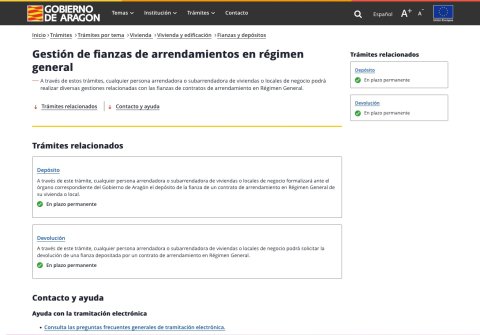Rental deposits: digitalization and service design - Aragón
Aragón (Spain)
The submission of the rental deposit in a public register is a compulsory procedure for all persons renting a property in Aragon. A high impact service that processes approximately 25,000 deposits and 18,000 returns each year. In order to facilitate the management of these deposits, the Government of Aragon has redesigned the service to simplify it and facilitate the completion of this procedure in full by digital means.
Before the redesign, the physical stamping of documents was a requirement to complete the process. The Social Housing Service and SDA · Servicios Digitales de Aragón have worked on the elimination of this stamp, an obsolete procedure which has been replaced by a digital receipt. The service has been integrated in the ecosystem of digital tools of the Government of Aragon, usable and accessible, with a user-centred perspective. The digitalisation of the process also results in a better service for those users who use the in-person or telephone channels to resolve doubts and queries about the procedures.
New processes, adapted to different user personas, have been designed using service design methodologies, with a focus on user experience. The content design, as well as the creation of digital interfaces, follows principles of accessibility and usability. All of this is integrated into the Government of Aragon's own ecosystem of digital tools.
Through the user journey design, the administrative burden has been reduced by eliminating a step that had become obsolete in a digital context, but was still present in regulations.
By eliminating the physical stamp that has been replaced by a more reliable, easier to obtain and send electronic document, other administrations that used to require the physical stamp have adopted the electronic conformity as a valid document.
As a result of the simplification of the service and its procedures, users who feel comfortable using digital channels gain autonomy. Immediately, the delay in getting a face-to-face appointment has been largely reduced.It is also expected that the volume of queries will be much lower, thanks to the extended information available on the corporate website aragon.es.
As a consequence of this, Service staff will have more quality time available to attend to and inform citizens, and to accompany the procedures or resolve the doubts of those who prefer or need to continue to carry out procedures and formalities both in person and by telephone.
The SDA team and the Social Housing Service team have been working on an eight-month process using SDA's own service design methodology. This methodology involves service staff and design professionals working together to research the existing service, identify opportunities for improvement and jointly create solutions to address them.
To this end, they have used different design techniques, such as the creation of user archetypes and the definition of the service experience map. A new map has also been defined, with all the changes that this new approach to the service entails, both in the points of contact between users and the administration, and in the service's internal processes.
The process involved field interviews (8) in-depth interviews (9) mystery customers (4) office visits (5) interviews with professionals (5) and the participation of 10 individuals and 9 professionals (estate agents, property management companies).
